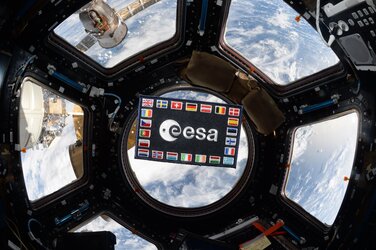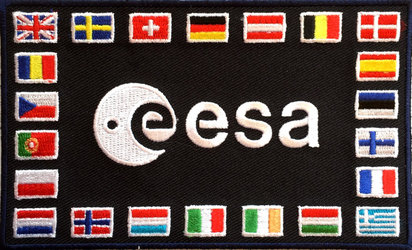About the mission logos
The European space laboratory Columbus takes its name from the famous Genoan navigator Christopher Columbus who made the notable voyages to the Americas from 1492 to 1504.
Columbus logo
The lower half of the Columbus logo consists of a lighter blue circle symbolising Earth. This is surrounded by a darker blue ellipse which signifies the initial orbit of the Space Shuttle that transported Columbus after launch. Above these, the International Space Station is shown at its higher orbiting altitude.
The white stripe across Earth symbolises two things. Firstly, it symbolises the path from east to west, which Christopher Columbus took on his way to the Americas. Secondly, it symbolises the path of the Columbus laboratory from west to east from the launch pad in Florida, USA, into orbit and to the International Space Station, following an orbital path symbolised by the stars.
The stars (10 gold and one blue) symbolise the 11 ESA Member States that contributed to ESA's human spaceflight programme at the time of launch. With the last star being the central part of the Space Station, the stars also symbolise how the Columbus laboratory, following its orbital journey, is an integral part of the International Space Station.
The final star also symbolises the spark of genius inherent in the groundbreaking science that takes place in the laboratory.
Shuttle mission patch

NASA's STS-122 patch depicts the continuation of the voyages of the early explorers to today's frontier, space. The ship denotes the travels of the early expeditions from the east to the west. The Space Shuttle indicates the continuation of that journey along the orbital path from west to east.
A little more than 500 years after Columbus sailed to the new world, the STS-122 crew brought the European laboratory Columbus to the International Space Station to usher in a new era of scientific discovery.









